The non-woven fabric rolls market is projected to expand from USD 9.2 billion in 2025 to USD 14.9 billion by 2035, growing at a CAGR of 4.9% and adding USD 5.7 billion in total value. The growth of nearly 1.6 times will be supported by accelerating adoption in medical, hygiene, agricultural, and industrial manufacturing sectors, where non-woven fabric rolls deliver superior strength, consistency, and production efficiency compared to traditional textile methods. Manufacturers are increasingly shifting toward spunbond and meltblown configurations, integrating advanced fiber technology with automated manufacturing platforms to optimize material utilization and reduce waste by 35–50% across production cycles. Expansion is being reinforced by the healthcare sector’s rising reliance on disposable non-woven products such as surgical drapes, gowns, wound dressings, and hygiene materials, where consistent fabric performance and cost efficiency remain crucial. Industrial manufacturers are also embedding non-woven roll systems within process automation frameworks to enhance throughput and minimize material variation. Spunbond technology dominates with 58% share, benefiting from high production efficiency and versatile mechanical properties, while the medical industry segment accounts for 45% market share, reflecting widespread use across healthcare facilities and device fabrication units.
Across major economies, China (6.6% CAGR) and India (6.1%) are emerging as manufacturing powerhouses, driven by expanding industrial zones, government-supported modernization schemes, and healthcare infrastructure growth. Germany (5.6%) and Brazil (5.1%) maintain consistent demand through advanced textile innovation and localized fabrication networks. The U.S. (4.7%), U.K. (4.2%), and Japan (3.7%) continue to integrate high-performance non-woven systems within automated industrial processes and precision medical manufacturing. Leading companies such as Probtain, Betford, and Soonercleaning collectively capture around 30% market share, leveraging R&D in fiber optimization and international distribution to meet demand across healthcare, agriculture, and industrial fabrication.
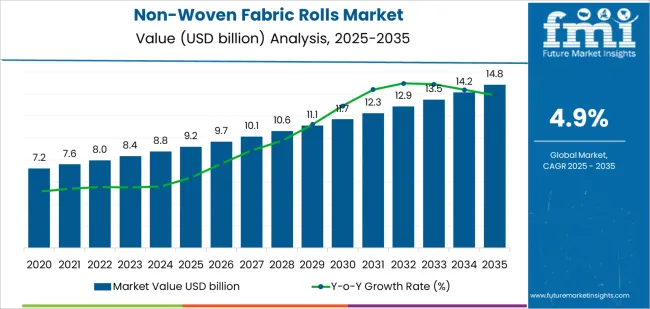
Non-Woven Fabric Rolls Market Year-over-Year Forecast (2025-2035)
The market demonstrates strong momentum across developed and emerging manufacturing economies, where textile industries are transitioning from conventional fabric methods to advanced non-woven systems that offer superior performance characteristics. Non-woven fabric roll technology addresses critical manufacturing challenges including material versatility optimization, production efficiency consistency, and application adaptability across extended production cycles. The healthcare sector's shift toward disposable medical products and hygiene-focused applications creates sustained demand for fabric solutions capable of processing various material compositions and application requirements with minimal processing complexity and consistent quality output.
Industrial manufacturers and textile producers are investing in non-woven fabric roll systems to enhance competitive positioning through improved production efficiency and expanded application capabilities. The integration of advanced fiber technologies and optimized manufacturing configurations enables these products to achieve performance standards 40-55% higher than conventional systems while maintaining cost-effectiveness performance. However, initial capital investment requirements for specialized manufacturing equipment and technical expertise barriers for optimal process optimization may pose challenges to market expansion in cost-sensitive manufacturing segments and regions with limited access to advanced textile production resources.
Between 2025 and 2030, the non-woven fabric rolls market is projected to expand from USD 9.2 billion to USD 12.3 billion, resulting in a value increase of USD 3.1 billion, which represents 54.2% of the total forecast growth for the decade. This phase of development will be shaped by rising demand for hygiene and medical applications in healthcare and consumer sectors, product innovation in fiber technology and manufacturing processes, as well as expanding integration with advanced production platforms and automated manufacturing lines. Companies are establishing competitive positions through investment in advanced non-woven manufacturing, quality optimization technologies, and strategic market expansion across medical industry applications, agricultural sectors, and industrial fabrication operations.
From 2030 to 2035, the market is forecast to grow from USD 12.3 billion to USD 14.9 billion, adding another USD 2.6 billion, which constitutes 45.8% of the overall ten-year expansion. This period is expected to be characterized by the expansion of specialized fabric systems, including advanced fiber compositions and multi-functional roll configurations tailored for specific application requirements and performance specifications, strategic collaborations between fabric manufacturers and end-user industries, and an enhanced focus on sustainability optimization and performance enhancement. The growing emphasis on eco-friendly manufacturing and application versatility will drive demand for advanced, high-performance non-woven fabric roll solutions across diverse industrial applications.
| Metric | Value |
|---|---|
| Market Value (2025) | USD 9.2 billion |
| Market Forecast Value (2035) | USD 14.9 billion |
| Forecast CAGR (2025-2035) | 4.9% |
The Non-Woven Fabric Rolls market grows by enabling manufacturers to achieve superior material performance and production efficiency while reducing manufacturing complexity in diverse industrial operations. Manufacturing facilities face mounting pressure to improve product quality and cost effectiveness, with non-woven fabric roll systems typically providing 35-50% material efficiency improvement over conventional textile methods, making these specialized products essential for competitive manufacturing operations. The medical and agricultural industries' need for versatile fabric solutions creates demand for advanced non-woven products that can maintain performance consistency, achieve excellent application adaptability, and ensure reliable functionality across diverse industrial requirements and operating conditions.
Industrial modernization initiatives promoting advanced manufacturing and sustainable production drive adoption in medical device manufacturing, agricultural applications, and industrial fabrication facilities, where material performance has a direct impact on product quality and operational costs. The global shift toward sustainable manufacturing principles and eco-friendly production implementation accelerates non-woven fabric roll demand as manufacturing facilities seek textile solutions that minimize environmental impact and maximize material utilization. However, limited awareness of optimal application protocols and higher initial material costs compared to conventional textiles may limit adoption rates among smaller manufacturers and regions with traditional textile practices and limited technical support infrastructure.
The market is segmented by production process, application, and region. By production process, the market is divided into Spunbond, Meltblown, and Others. Based on application, the market is categorized into Medical Industry, Agriculture, and Others. Regionally, the market is divided into Asia Pacific, Europe, North America, Latin America, and Middle East & Africa.
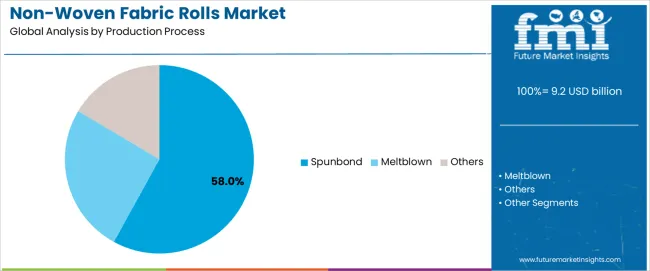
The Spunbond segment represents the dominant force in the Non-Woven Fabric Rolls market, capturing approximately 58% of total market share in 2025. This advanced category encompasses continuous filament processes, thermally bonded configurations, and specialized fiber arrangements optimized for high-performance fabric applications, delivering superior strength characteristics and manufacturing consistency in non-woven production operations. The Spunbond segment's market leadership stems from its proven manufacturing efficiency, enhanced durability performance, and compatibility with diverse application requirements across medical industry applications, agricultural sectors, and industrial manufacturing facilities.
The Meltblown segment maintains a substantial 24% market share, serving applications that require fine fiber structures through specialized filtration capabilities and barrier properties. The Others segment represents 18% market share through alternative production methods including needle-punched, thermal bonded, and chemical bonded processes.
Key advantages driving the Spunbond segment include:
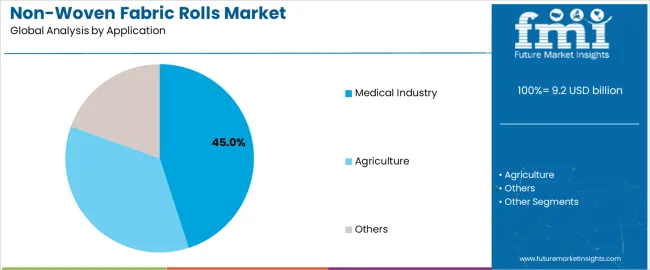
Medical Industry applications dominate the non-woven fabric rolls market with approximately 45% market share in 2025, reflecting the extensive adoption of non-woven materials across surgical products, hygiene applications, and disposable medical devices. The Medical Industry segment's market leadership is reinforced by widespread implementation in hospital supply systems, medical device manufacturing, and healthcare facility operations, which provide essential performance capabilities and safety consistency in critical healthcare environments.
The Agriculture segment represents 28% market share through specialized applications including crop protection covers, soil stabilization materials, and agricultural filtration systems. The Others segment accounts for 27% market share, encompassing industrial applications, construction materials, and consumer products requiring versatile fabric solutions.
Key market dynamics supporting application preferences include:
The market is driven by three concrete demand factors tied to industrial efficiency and application performance. First, healthcare industry expansion creates increasing requirements for disposable medical products, with global healthcare expenditure exceeding 8 trillion annually in major markets worldwide, requiring reliable non-woven fabric roll systems for surgical applications, hygiene products, and medical device manufacturing operations. Second, agricultural modernization and crop protection advancement drive adoption of specialized fabric technology, with non-woven fabric rolls improving agricultural efficiency by 35-50% while reducing material costs in farming applications used extensively in crop protection systems and soil management programs. Third, industrial automation initiatives and sustainable manufacturing proliferation accelerate deployment across manufacturing facilities, with non-woven fabric rolls integrating seamlessly with automated production lines and enabling efficient material utilization capabilities in eco-friendly manufacturing environments.
Market restraints include raw material cost volatility affecting manufacturing economics and price-sensitive application segments, particularly where conventional textile alternatives remain viable for basic applications and where material budgets constrain adoption of specialized non-woven systems. Technical expertise requirements for optimal process optimization pose adoption challenges for facilities lacking experienced textile engineers, as fabric performance depends heavily on proper fiber selection, bonding parameters, and application techniques that vary significantly across material types and end-use requirements. Limited availability of specialized technical support in emerging manufacturing markets creates additional barriers, as manufacturing facilities require training in production optimization procedures, quality control methods, and application-specific customization to achieve target performance levels.
Key trends indicate accelerated adoption in Asian manufacturing hubs, particularly China and India, where textile manufacturing capabilities and industrial production infrastructure are expanding rapidly through government industrialization programs and international investment in manufacturing development. Technology advancement trends toward bio-based fiber materials with enhanced sustainability profiles, smart fabric integration with functional capabilities, and modular production systems enabling customizable fabric properties are driving next-generation product development. However, the market thesis could face disruption if advanced synthetic alternatives achieve breakthrough capabilities in cost-effectiveness and performance characteristics, potentially reducing demand for traditional non-woven fabric solutions in specific industrial applications.

| Country | CAGR (2025-2035) |
|---|---|
| China | 6.6% |
| India | 6.1% |
| Germany | 5.6% |
| Brazil | 5.1% |
| U.S. | 4.7% |
| U.K. | 4.2% |
| Japan | 3.7% |
The Non-Woven Fabric Rolls market is gaining momentum worldwide, with China taking the lead thanks to aggressive textile manufacturing expansion and industrial development programs. Close behind, India benefits from growing manufacturing infrastructure capabilities and government industrialization initiatives, positioning itself as a strategic growth hub in the Asia-Pacific region. Brazil shows strong advancement, where expanding industrial operations and manufacturing infrastructure development strengthen its role in South American textile supply chains. The U.S. demonstrates robust growth through advanced manufacturing initiatives and industrial sector investment, signaling continued adoption in specialized fabric applications. Meanwhile, Japan stands out for its precision manufacturing expertise and advanced textile technology integration, while U.K. and Germany continue to record consistent progress driven by industrial manufacturing centers and textile production facilities. Together, China and India anchor the global expansion story, while established markets build stability and technology leadership into the market's growth path.
The report covers an in-depth analysis of 40+ countries, the top-performing countries are highlighted below.
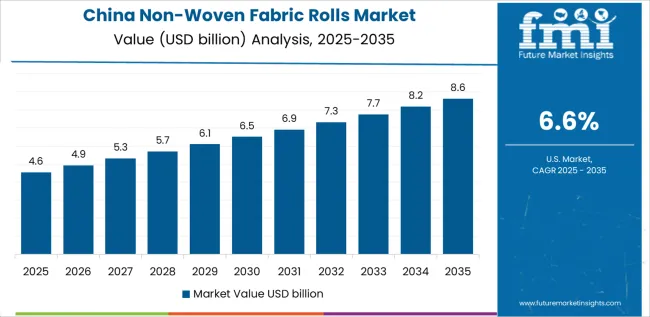
China demonstrates the strongest growth potential in the Non-Woven Fabric Rolls Market with a CAGR of 6.6% through 2035. The country's leadership position stems from comprehensive textile manufacturing expansion, intensive industrial development programs, and aggressive manufacturing modernization targets driving adoption of advanced non-woven fabric technologies. Growth is concentrated in major manufacturing regions, including Guangdong, Jiangsu, Zhejiang, and Shandong, where textile manufacturers, industrial producers, and medical device companies are implementing non-woven fabric roll systems for production enhancement and cost optimization. Distribution channels through industrial equipment distributors, textile specialists, and direct manufacturer relationships expand deployment across textile manufacturing clusters, industrial development zones, and medical device production centers. The country's Made in China 2025 initiative provides policy support for advanced textile technology adoption, including subsidies for manufacturing equipment procurement and production infrastructure upgrades.
Key market factors:
In major industrial regions including Mumbai, Delhi, Bangalore, and Chennai, the adoption of non-woven fabric roll systems is accelerating across textile manufacturers, industrial facilities, and medical device operations, driven by government industrialization initiatives and increasing focus on manufacturing competitiveness. The market demonstrates strong growth momentum with a CAGR of 6.1% through 2035, linked to comprehensive manufacturing sector expansion and increasing investment in advanced textile capabilities. Indian manufacturers are implementing non-woven fabric roll technology and modern production platforms to improve manufacturing efficiency while meeting quality requirements in industrial environments serving domestic and export markets. The country's Make in India initiative creates sustained demand for advanced textile solutions, while increasing emphasis on manufacturing modernization drives adoption of specialized fabric systems that enhance production productivity.
Germany's advanced manufacturing sector demonstrates sophisticated implementation of non-woven fabric roll systems, with documented case studies showing 40-45% production efficiency improvement in textile operations through optimized fabric strategies. The country's manufacturing infrastructure in major industrial regions, including Bavaria, Baden-Württemberg, North Rhine-Westphalia, and Lower Saxony, showcases integration of advanced textile technologies with existing production equipment, leveraging expertise in industrial manufacturing and medical device production. German manufacturers emphasize quality standards and process optimization, creating demand for reliable non-woven fabric roll solutions that support production commitments and stringent quality requirements. The market maintains strong growth through focus on manufacturing excellence and facility modernization, with a CAGR of 5.6% through 2035.
Key development areas:
The Brazilian market leads in Latin American non-woven fabric rolls adoption based on expanding manufacturing operations and growing industrial infrastructure in major production centers. The country shows solid potential with a CAGR of 5.1% through 2035, driven by industrial sector investment and increasing domestic demand for advanced textile materials across manufacturing, agricultural, and medical sectors. Brazilian manufacturers are adopting non-woven fabric roll technology for compliance with international quality standards, particularly in medical applications requiring specialized material properties and in industrial applications where fabric performance impacts production economics. Technology deployment channels through industrial distributors, textile representatives, and equipment financing programs expand coverage across manufacturing supply chains and industrial facilities.
Leading market segments:
The U.S. market leads in advanced non-woven fabric rolls applications based on integration with sophisticated manufacturing systems and comprehensive production platforms for enhanced operational efficiency. The country shows solid potential with a CAGR of 4.7% through 2035, driven by industrial expansion and increasing adoption of advanced textile technologies across medical device manufacturing, agricultural applications, and industrial production sectors. American manufacturers are implementing non-woven fabric roll systems for high-precision applications, particularly in medical device production demanding specialized material properties and in industrial applications where fabric consistency directly impacts product quality. Technology deployment channels through industrial distributors, textile specialists, and direct manufacturer relationships expand coverage across diverse manufacturing operations.
Leading market segments:
The U.K. market demonstrates consistent implementation focused on industrial manufacturing and medical device production, with documented integration of non-woven fabric roll systems achieving 32-38% operational efficiency improvements in manufacturing operations. The country maintains steady growth momentum with a CAGR of 4.2% through 2035, driven by manufacturing presence and medical industry requirements for advanced textile capabilities in specialized applications. Major industrial regions, including London, Manchester, Birmingham, and Scotland, showcase deployment of advanced fabric technologies that integrate with existing manufacturing infrastructure and support quality requirements in industrial and medical supply chains.
Key market characteristics:
The non-woven fabric rolls market in Japan demonstrates sophisticated implementation focused on manufacturing operations and medical device production, with documented integration of advanced fabric systems achieving 35-40% manufacturing consistency improvement in precision industrial operations. The country maintains steady growth momentum with a CAGR of 3.7% through 2035, driven by manufacturing excellence culture and emphasis on production optimization principles aligned with quality manufacturing philosophies. Major industrial regions, including Tokyo, Osaka, Nagoya, and Yokohama, showcase advanced deployment of specialized textile technologies that integrate seamlessly with automated manufacturing systems and comprehensive quality control protocols.
Key market characteristics:

The non-woven fabric rolls market in Europe is projected to grow from USD 3.5 billion in 2025 to USD 5.6 billion by 2035, registering a CAGR of 4.9% over the forecast period. Germany is expected to maintain its leadership position with a 30.8% market share in 2025, declining slightly to 30.4% by 2035, supported by its extensive manufacturing infrastructure and major industrial centers, including leading textile manufacturers and medical device production facilities.
France follows with a 19.2% share in 2025, projected to reach 19.5% by 2035, driven by comprehensive manufacturing facility modernization and industrial development programs in major production regions. The United Kingdom holds a 15.6% share in 2025, expected to reach 15.9% by 2035 through manufacturing excellence and medical device facilities. Italy commands a 13.4% share in both 2025 and 2035, backed by textile manufacturing programs and industrial production operations. Spain accounts for 9.8% in 2025, rising to 10% by 2035 on manufacturing expansion and industrial sector growth. The Rest of Europe region is anticipated to hold 11.2% in 2025, expanding to 11.4% by 2035, attributed to increasing Non-Woven Fabric Rolls adoption in Nordic manufacturing institutions and emerging Central & Eastern European textile production operations.
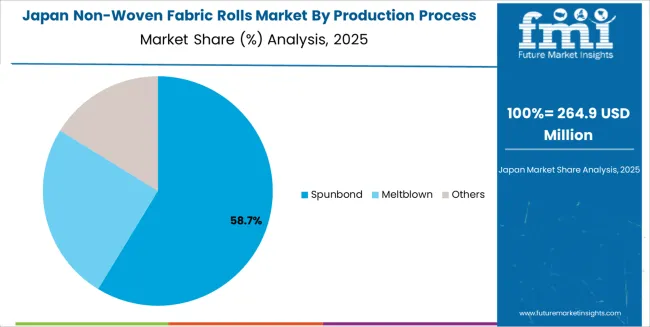
The Japanese non-woven fabric rolls market demonstrates a mature and quality-focused landscape, characterized by sophisticated integration of advanced fiber systems with existing precision manufacturing infrastructure across textile producers, medical device manufacturers, and industrial fabrication operations. Japan's emphasis on manufacturing excellence and production precision drives demand for fabric systems that support quality commitments and performance effectiveness targets in competitive manufacturing environments. The market benefits from strong partnerships between international fabric providers and domestic industrial distributors including major trading companies, creating comprehensive service ecosystems that prioritize technical support and application optimization programs. Manufacturing centers in Tokyo, Osaka, Nagoya, and other major industrial areas showcase advanced textile implementations where non-woven fabric roll systems achieve 93% quality compliance through optimized production parameters and comprehensive quality control systems.
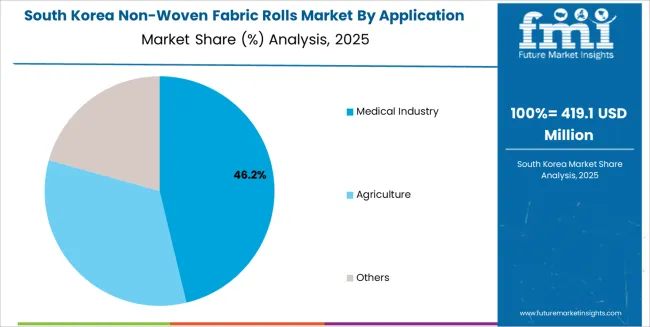
The South Korean non-woven fabric rolls market is characterized by growing international technology provider presence, with companies maintaining significant positions through comprehensive technical support and application optimization capabilities for manufacturing and medical device applications. The market demonstrates increasing emphasis on manufacturing automation and production enhancement, as Korean manufacturers increasingly demand advanced fabric solutions that integrate with domestic industrial infrastructure and sophisticated production management systems deployed across major manufacturing complexes. Regional industrial distributors are gaining market share through strategic partnerships with international manufacturers, offering specialized services including technical training programs and application-specific fabric solutions for textile and industrial operations. The competitive landscape shows increasing collaboration between multinational fabric companies and Korean manufacturing technology specialists, creating hybrid service models that combine international product development expertise with local technical support capabilities and rapid response systems.
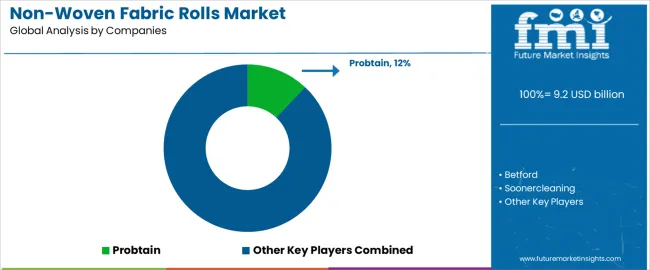
The non-woven fabric rolls market features approximately 25-30 meaningful players with moderate fragmentation, where the top three companies control roughly 28-35% of global market share through established distribution networks and comprehensive product portfolios. Competition centers on fabric quality consistency, manufacturing reliability, and technical support capabilities rather than price competition alone. Probtain leads with approximately 12% market share through its comprehensive non-woven fabric portfolio and specialized textile manufacturing expertise.
Market leaders include Probtain, Betford, and Soonercleaning, which maintain competitive advantages through global distribution infrastructure, advanced fiber technology, and deep expertise in textile manufacturing across multiple industrial sectors, creating trust and reliability advantages with manufacturing facilities and industrial operation centers. These companies leverage research and development capabilities in fiber technology optimization and ongoing technical support relationships to defend market positions while expanding into emerging manufacturing markets and specialized application segments.
Challengers encompass The Associated Technology Group and Guangzhou Environstar Enterprise, which compete through specialized product offerings and strong presence in key manufacturing markets. Product specialists, including Wipex Nonwovens, Suzhou Meson Nonwoven Technology, and Star Construction Systems, focus on specific fabric configurations or regional markets, offering differentiated capabilities in custom textile solutions, rapid delivery services, and competitive pricing structures.
Regional players and emerging fabric manufacturers create competitive pressure through localized production advantages and rapid response capabilities, particularly in high-growth markets including China and India, where proximity to manufacturing clusters provides advantages in technical support responsiveness and customer relationships. Market dynamics favor companies that combine proven fabric performance with comprehensive manufacturing offerings that address the complete textile cycle from material development through application optimization and quality assurance.
| Item | Value |
|---|---|
| Quantitative Units | USD 9.2 billion |
| Production Process | Spunbond, Meltblown, Others |
| Application | Medical Industry, Agriculture, Others |
| Regions Covered | Asia Pacific, Europe, North America, Latin America, Middle East & Africa |
| Country Covered | China, India, Germany, Brazil, U.S., U.K., Japan, and 40+ countries |
| Key Companies Profiled | Probtain, Betford, Soonercleaning, The Associated Technology Group, Guangzhou Environstar Enterprise, Wipex Nonwovens, Suzhou Meson Nonwoven Technology, Star Construction Systems, Dermcosy Medical, NBC Meshtec, Wöhler Technik, Phoenix Fabrikations, PlanetNonWovens |
| Additional Attributes | Dollar sales by production process and application categories, regional adoption trends across Asia Pacific, Europe, and North America, competitive landscape with fabric manufacturers and distribution networks, manufacturing facility requirements and specifications, integration with production systems and automated manufacturing lines, innovations in fiber technology and manufacturing processes, and development of specialized fabric solutions with enhanced performance and sustainability capabilities. |
The global non-woven fabric rolls market is estimated to be valued at USD 9.2 billion in 2025.
The market size for the non-woven fabric rolls market is projected to reach USD 14.8 billion by 2035.
The non-woven fabric rolls market is expected to grow at a 4.9% CAGR between 2025 and 2035.
The key product types in non-woven fabric rolls market are spunbond, meltblown and others.
In terms of application, medical industry segment to command 45.0% share in the non-woven fabric rolls market in 2025.






Full Research Suite comprises of:
Market outlook & trends analysis
Interviews & case studies
Strategic recommendations
Vendor profiles & capabilities analysis
5-year forecasts
8 regions and 60+ country-level data splits
Market segment data splits
12 months of continuous data updates
DELIVERED AS:
PDF EXCEL ONLINE
Key Companies & Market Share in the Non-Woven Fabric Sector
Non-Woven Fabric Market by Production Process from 2024 to 2034
Fabric Spreading Machine Market Forecast Outlook 2025 to 2035
Fabric Freshener Market Forecast and Outlook 2025 to 2035
Fabric Inspection Machine Market Size and Share Forecast Outlook 2025 to 2035
Fabric Cutting Machine Market Size and Share Forecast Outlook 2025 to 2035
Fabric Testing Equipment Market Size and Share Forecast Outlook 2025 to 2035
Fabric Toys Market Size and Share Forecast Outlook 2025 to 2035
Fabric Softener Sheet Market Size and Share Forecast Outlook 2025 to 2035
Fabric Filter System Market Size & Forecast 2025 to 2035
Fabric Softener Market Analysis by Nature, Product Type, End Use, Sales Channel & Region from 2025 to 2035
Fabric Care Market Analysis - Trends, Growth & Forecast 2025 to 2035
Fabric Odor Eliminator Market – Trends, Growth & Forecast 2025 to 2035
Fabric Stain Remover Market Growth – Trends, Demand & Innovations 2025-2035
Global Fabric Cutting Machine Market Share Analysis – Trends & Forecast 2025–2035
Fabric Starch Market
Prefabricated Composite Sandwich Panels Market Size and Share Forecast Outlook 2025 to 2035
Prefabricated Bathroom Pods Market Size and Share Forecast Outlook 2025 to 2035
Prefabricated Building System Market Growth - Trends & Forecast 2025 to 2035
Mesh Fabric Market Size and Share Forecast Outlook 2025 to 2035

Thank you!
You will receive an email from our Business Development Manager. Please be sure to check your SPAM/JUNK folder too.
Chat With
MaRIA